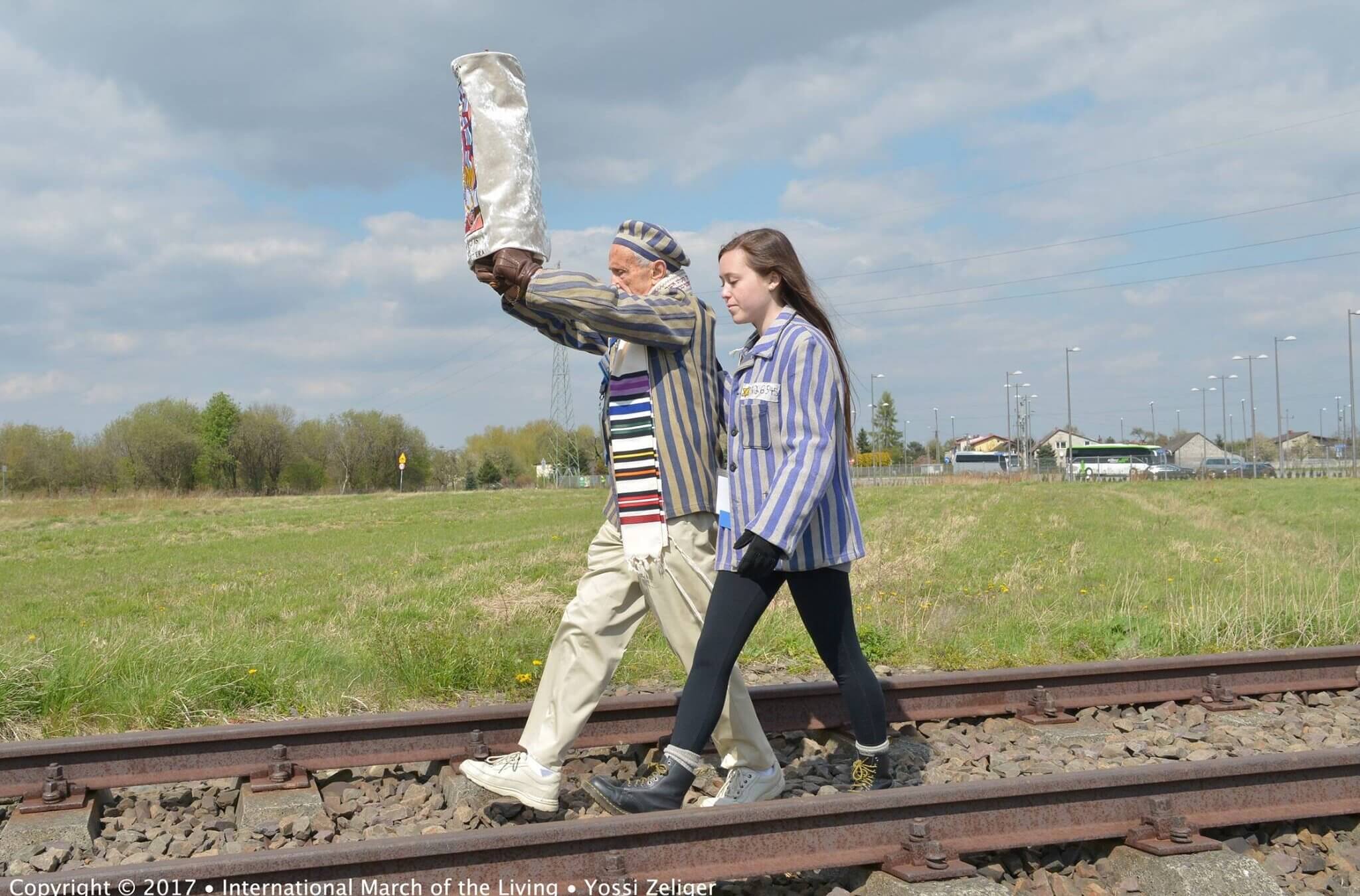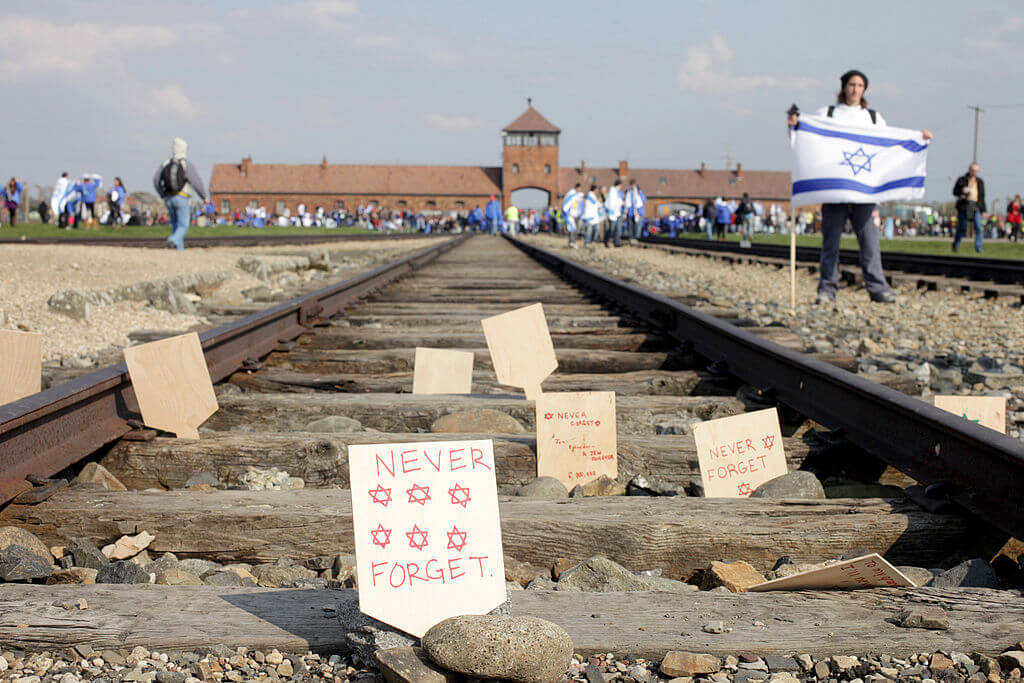I’m joining this year’s March of the Living. It may be the last to include survivors
In 2019, 70 Holocaust survivors walked the historic route from Auschwitz to Birkenau. This year, there will only be eight.

A Holocaust survivor holds a Torah scroll aloft as he walks with a young woman down the train tracks leading from Auschwitz to Birkenau. Photo by Yossi Zeliger/Getty Images
The last time the March of the Living took place at the Auschwitz-Birkenau complex in Poland there were 10,000 participants, including 70 Holocaust survivors. That was in 2019.
When the annual event reconvenes next week for Israel’s Holocaust Remembrance Day after a pandemic-induced hiatus, and with war raging in neighboring Ukraine, only 2,000 participants are expected, including eight survivors. One is Eve Kugler, who is 91 years old.
“With a heavy heart, I pass responsibility for the remembrance of the Holocaust to members of the third generation,” said Kugler, who was born in Germany but now resides in the U.K.
When I learned that this year’s march could well be the last including any survivors, I signed up to join the sole delegation from North America, a group of about 30 adults ages 19 to 70, some of whom have been waiting three years to attend.
I do not have Holocaust survivors in my family, and have never heard a survivor’s testimony in person; my Holocaust education began with a visit to the United States Memorial Holocaust Museum when I was 10, and a copy of “The Diary of Anne Frank” that my parents purchased at the museum gift shop.
Over the next week, I will immerse in this experience and interview as many of the survivors and other march participants as possible, sharing their stories via dispatches in our morning newsletter, videos, opinion columns and social media posts.
Estimates of the number of living survivors worldwide vary; the United States Holocaust Memorial Museum lists more than 195,000, but acknowledges that “a growing number of the individuals are now deceased.” There are an estimated 50,000 survivors in the United States, half of whom are over 85.

Since 1988, the International March of the Living has brought more than 260,000 students and adults from 52 different countries to walk the nearly two miles from Auschwitz to Birkenau alongside some of those survivors on Yom HaShoah, Israel’s Holocaust Remembrance Day.
Along with the keynote event at Auschwitz on Yom HaShoah, the March of the Living typically includes a week of educational programming in Poland, where delegations learn more about the history of Eastern European Jewry before World War II, followed by a week in Israel.
“It’s been a journey to get to the journey”
With the outbreak of the coronavirus in 2019, the organization had to quickly pivot, and broadcast a virtual event for both 2020 and 2021. Just as it was preparing for a return to an in-person program, Russia invaded Ukraine; one by one, all of the student delegations from North America decided not to participate.
“It’s been a journey to get to the journey,” said Avi Green, a trip organizer with Authentic Israel, who has partnered with BBYO to lead the sole remaining North American (adult) delegation.
The war in Ukraine is not affecting the delegation’s itinerary from a security perspective: all of the standard sites such as the Warsaw Ghetto, the Treblinka death camp and the Jewish quarter of Krakow remain on the schedule. Yet it is impossible to ignore the violence and attendant refugee crisis on Poland’s border.
“We deal with war, death, dying and intolerance every march,” remarked Phyllis Greenberg Heideman, president of the March of the Living. “This year is no different.”

The delegation I am joining will be preparing aid packages to deliver to Ukrainian refugees in Warsaw, and trip organizers repeatedly expressed to me how eager fellow participants were to be of service. “The juxtaposition of the March’s mission and the current situation in Ukraine is too powerful to ignore,” Toby Ayash, one of the organizers, told me.
For the survivors themselves, the war in Ukraine has been traumatizing, especially the images and videos of civilian death on a scale that has not been seen in decades.
“It’s been really hard for them to realize that in 2022, we are still seeing images of mass graves,” Heideman said. For survivors, she added, “the news out of Ukraine has been incredibly debilitating.” (A Ukrainian Holocaust survivor died this month in a basement in Mariupol amid Russian shelling.)
The majority of this year’s 2,000 participants are coming from Israel and Europe. All of the eight survivors attending are European or British – a testament to the age of the survivor community and the difficulty international travel poses in light of the ongoing pandemic.
There are other ways this year’s march will be distinct. For the first time ever, a representative from an Arab country – the United Arab Emirates – will be in attendance, in addition to Jewish Ukrainians who have only recently fled the war.
COVID and conflict may have dramatically cut short the attendance list, but there is a deep sense of gratitude from every organizer I spoke with that the March is occurring in person again at all.
The responsibility to remember passes to the next generation
As I prepare myself on a logistical and emotional level, I can’t help but think of the many recent surveys among my generation that point to several disturbing trends: the rise of Holocaust denial or misinformation online, and a growing lack of basic Holocaust knowledge.
In a 2020 Claims Conference poll, 49% of Gen Z and Millennials nationwide said they had seen Holocaust denial or distortion posts on social media, and 11% said they believe that Jews were responsible for the Holocaust.
Amid rising antisemitism in the U.S. and the misguided belief that Jews are no longer a marginalized people worthy of protection or of including in diversity initiatives, I worry about how it is possible to educate the third, fourth and fifth generations about the Holocaust with more survivors succumbing to old age by the day.
How can we fulfill the mission of never forgetting the six million without the testimony of living survivors?
Heideman reassured me that her group has worked to preserve “myriad testimonies” during the pandemic and that its shift to virtual programming has meant reaching millions more people than could ever possibly attend the march.
“Nothing can replace seeing the sites in person,” Heideman stresses, “but our mission is to remember, and we will not be deterred.”
















